
The House of Stuart, originally spelled Stewart, was a royal house of Scotland, England, Ireland and later Great Britain. The family name comes from the office of High Steward of Scotland, which had been held by the family progenitor Walter fitz Alan. The name Stewart and variations had become established as a family name by the time of his grandson Walter Stewart. The first monarch of the Stewart line was Robert II, whose male-line descendants were kings and queens in Scotland from 1371, and of England, Ireland and Great Britain from 1603, until 1714. Mary, Queen of Scots, was brought up in France where she adopted the French spelling of the name Stuart.
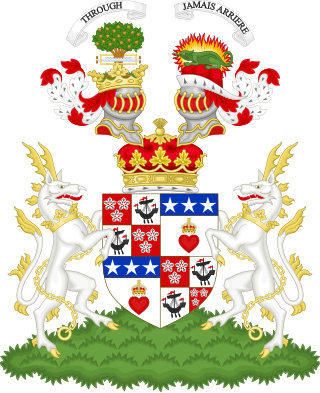
Duke of Hamilton is a title in the Peerage of Scotland, created in April 1643. It is the senior dukedom in that peerage, and as such its holder is the premier peer of Scotland, as well as being head of both the House of Hamilton and the House of Douglas. The title, the town of Hamilton in Lanarkshire, and many places around the world are named after members of the Hamilton family. The ducal family's surname, originally "Hamilton", is now "Douglas-Hamilton". Since 1711, the dukedom has been held together with the Dukedom of Brandon in the Peerage of Great Britain, and the dukes since that time have been styled Duke of Hamilton and Brandon, along with several other subsidiary titles.
The Lord of Abernethy was from the 12th century to the 14th century the hereditary holder of the church and lands of the Scottish monastery at Abernethy. It gradually evolved alongside the title Abbot of Abernethy, displacing that term in extant sources by the end of the 13th century. It was held by the descendants of Gille Míchéil, Earl of Fife.
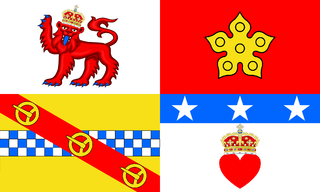
The Mormaer or Earl of Angus was the ruler of the medieval Scottish province of Angus. The title, in the Peerage of Scotland, is held by the Duke of Hamilton, and is used as a courtesy title for the eldest son of the Duke's eldest son.
Patrick Hepburn, 1st Earl of Bothwell was Lord High Admiral of Scotland. He rose to political prominence after supporting James IV against his father, and was proxy at the King's marriage.
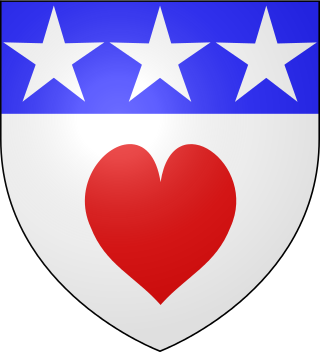
This page is concerned with the holders of the forfeit title Earl of Douglas and the preceding feudal barons of Douglas, South Lanarkshire. The title was created in the Peerage of Scotland in 1358 for William Douglas, 1st Earl of Douglas, son of Sir Archibald Douglas, Guardian of Scotland. The Earldom was forfeited by James Douglas, 9th Earl of Douglas, in 1455.

The Lord Warden of the Marches was an office in the governments of Scotland and England. The holders were responsible for the security of the border between the two nations, and often took part in military action. They were also responsible, along with 'Conservators of the truce', for administering the special type of border law known as March law.

Sir William Douglas "le Hardi", Lord of Douglas was a Scottish nobleman and soldier.
George Douglas, 1st Earl of Angus (1380–1403) was a Scottish nobleman and peer.
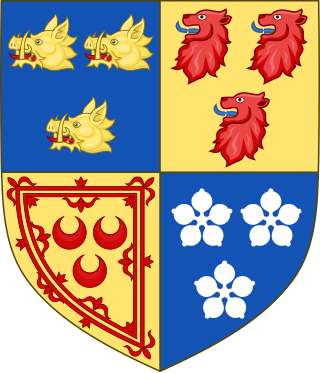
Alexander Seton, 1st Earl of Huntly, who adopted the family name of Gordon from about 1457, was a powerful 15th-century Scottish magnate. He was knighted in 1439/1440 and was Lord of Badenoch, Gordon, Strathbogie and Cluny.
William Douglas, 2nd Earl of Angus was a Scottish nobleman and soldier. The son of George Douglas, 1st Earl of Angus and Princess Mary of Scotland, he was a grandson of King Robert III.
George Douglas, 4th Earl of Angus, Lord Douglas, Abernethy and Jedburgh Forest was a Scottish nobleman. He was the son of William Douglas, 2nd Earl of Angus and Margaret Hay of Yester. Known as the Great Earl of Angus. He succeeded to the Earldom following the death of his childless brother James Douglas, 3rd Earl of Angus in 1446. He was to become the first Red Chief of Douglas.
George Douglas, Master of Angus was a Scottish Nobleman. The son of Archibald Douglas, 5th Earl of Angus and Elizabeth Boyd, daughter of Robert Boyd, 1st Lord Boyd, he was born at Tantallon Castle and died at the Battle of Flodden.
William Douglas, 1st Marquess of Douglas and 11th Earl of Angus (1589–1660) was a Scottish nobleman.

FitzAlan is an English patronymic surname of Anglo-Norman origin, descending from the Breton knight Alan fitz Flaad, who accompanied king Henry I to England on his succession. He was grandson of the Seneschal of the Bishop of Dol. The FitzAlan family shared a common patrilineal ancestry with the House of Stuart.
Alexander de Abernethy was a Scottish baron. He was a son of Hugh de Abernethy and Maria de Ergadia. Alexander was a descendant of abbots of Abernethy; his great-grandfather Laurence, great-grandson of Gillemichael, Earl of Fife, was the first to style himself Lord (dominus) His daughter Margaret married John Stewart of Bonkyll, the new Scottish earl of Angus.
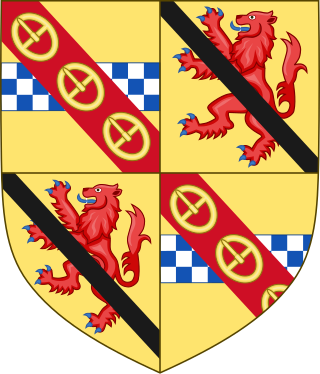
Thomas Stewart, 2nd Earl of Angus (b.b.1331-1361) was a medieval Scottish nobleman.
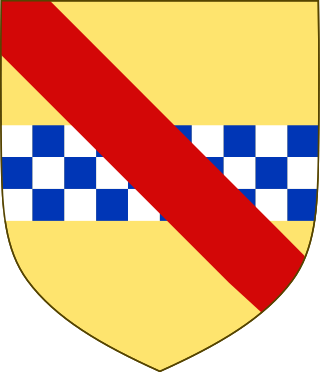
Sir John Stewart, the brother of Sir James the 5th High Steward of Scotland, was a Scottish knight and military commander during the First Scottish War of Independence.

Bonkyll Castle was a medieval fortress situated in the historic Scottish county of Berwickshire, from 1973 the Scottish Borders. It is situated 4 miles north of Duns and 4 miles south of Grantshouse. Few traces survive and the site is protected as a scheduled monument. It was the seat of a junior branch of the Stewart family, known as "Stewart of Bonkyl", from which was descended in another junior branch "Stewart of Darnley", the paternal family of King James VI & I of Scotland and England.

Alexander Stewart of Bonkyll was a Scottish nobleman. He was the eldest son of Sir John Stewart, and the father of John Stewart, 1st Earl of Angus.











